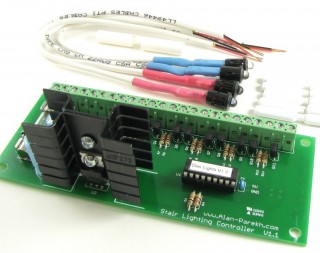Stair Lights
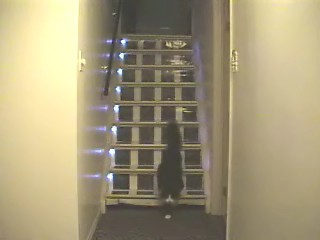
Cat coming down the stairs after activating the top stair beam sensor which turned the LED stair lights on. When the lights are off and it is dark outside these lights are this cat’s best friend.
Stair Lighting Controller Kit
This project is now available as a kit! The documentation is available here and the kit parts are available here. The prototype shown below is a very crude demonstration of the stair lighting idea. The Stair Lighting Controller Kit is a much more refined version that is available in kit form or fully assembled, tested and ready to install. It has built on the concept of the prototype but it has been designed for a simple installation process. The beams have also been greatly enhanced, they are now IR (infrared) beams which allow for a simple to install invisible beam. There are also two types of on patterns available, you can have the standard ramp on where all of the lights ramp up in intensity together or you can have the lights light one step at a time as you use the stairs.
VIDEOS
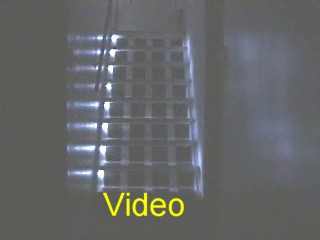
Watch a video (5.8 MB) of the stairs lights in operation! Shows breaking of the beam by me and then my cat. It is demonstrated in the dark so it can be difficult to see what is going on. |
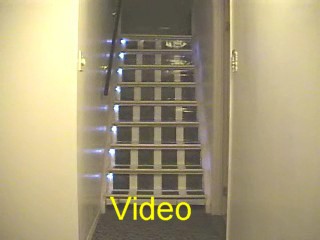
Another video, (4.8 MB) operating with the lights on. Shows breaking of the beam by me and then my cat. This time it is done with the lights on so it is easier to see what is happening. |
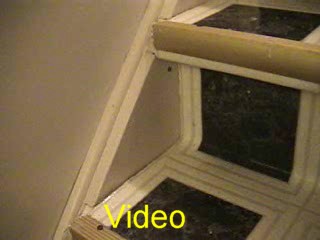
This video (2.2 MB)shows a close up of an LED, the laser output and the optical sensor. The laser beam can be seen on whatever breaks it, the laser was taken from inexpensive laser pointers and the laser sensor is actually an infrared transistor. The power of the laser has been reduced greatly so that it can’t cause any harm to someone looking directly into the beam. |
BACKGROUND
These lights were inspired by my cat. We have an older cat, and with old age comes a loss of agility, coordination and night sight. At night when the house lights are off I had heard the cat trip on the stairs to the basement. I needed to come up with a method of lighting the stairs at night when the house is dark. I thought that I could install a night light that comes on when it is dark. But this would have been too easy, there must be a more complex way to aid the cat. The end result is my microcontroller controlled stair lights. There is a laser beam at the top and bottom of the stairs, the height of the beams allows it to detect humans as well as our cat. There is an LED installed under each stair tread, this softly lights each stair.
OPERATION
When a beam is broken the lights ramp on, it might look as though they just turn on but there is a soft start algorithm that brings them from off to on quite quickly. There is then a delay to allow the person/animal to use the stairs. The lights then turn off one stair at a time following the person/animal. For example if the top beam was broken to activate the lights the lights will turn off starting with the top stair light. The lights ramp off at a slower more noticeable rate. There is also a small speaker that is connected to the system, the purpose was to be alerted if a small child was attempting to go upstairs. This speaker was mainly used while doing debugging, it has since been padded way down so that it is barely audible since it is not needed. Two buttons on the unit were going to be used to program the device and force the lights on or off. These have not completely been programmed since there has never been an occasion to need them.
Be informed when new projects are available or additional project information is posted by signing up to our mailing list.
PICTURES
This is in the mechanical room on the opposite wall of the stairs.
The Terminal block connects all of the external LEDs, lasers, sensors, etc. to the controller.
The ribbon cable connects the terminal block to the system.
There is a heat sinked 5 volt regulator at the top of the board, the heat sink is needed since this unit can require up 250mA of current at 5V when all of the stair LEDs are on. Rest current is about 30mA, this is mainly the green power on LED mounted on the board.
Two buttons were mounted and connected to the microcontroller, they were going to be for programming functions and also forcing the lights on or off as needed. This function has not been completed since there ended up being a lack of need for this function.
The speaker was helpful when debugging the system, it was also going to be used as a warning device, for example a child is trying to climb the stairs. The speaker has since been padded to be very quiet since the warning function is no longer needed.
Heat Sink for the 5V regulator.
Lower look at the board.
The laser is from a inexpensive laser pointer, it has been mounted on a channel that can be secured to a stud. There is enough flex in the steel so that it can be aimed easily.
Upper picture of the laser, the clear laser pointer end cap was used to attach the device to the steel.
Wiring for three of the stairs LEDs. (I know… I still have to clip the ends of the tie wrap cables)
Single stair LED power cable.
Close up of a stair LED.
Laser shining on hand.
Hole in wall where the laser beam comes out.
Take a look at the online store for kit purchasing options and prices!

